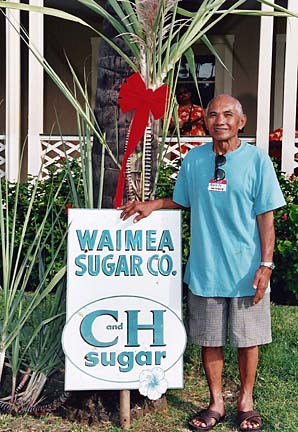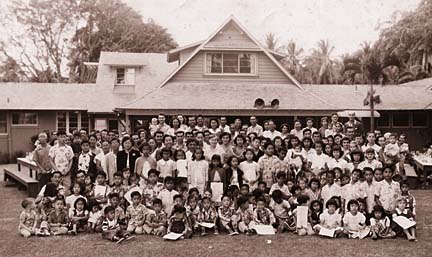

Hawaii’s
Back yard
Cheryl Chee Tsutsumi
Kauai tour acts
as a loving tribute
to plantation life
When Chris Faye was growing up, the emerald cane fields of Waimea were her playground. To her, the crackling sound of cane fires, big black puffs of smoke and roar of the field equipment were all part of "small kid time."
Plantation Lifestyles Walking Tour
Place: Start at Waimea Plantation Cottages administration building, 9400 Kaumualii Highway
Time: 9 a.m. Tuesdays, Thursdays and Saturdays by reservation only (subject to availability of volunteer guides); arrive by 8:45 a.m.
Cost: $10 for adults, $8 for ages 8 to 16, free for kids under 7. Discounts available to groups of at least eight by prior arrangement.
Notes: Wear light, comfortable clothing, as the climate in Waimea is usually hot and dry. Sturdy walking shoes, a hat and sunscreen are also recommended.
Call: 808-335-2824 weekdays during business hours or 808-337-1005 at other times.
Note: The tour benefits the Waimea Sugar Mill Museum in Camp House No. 2, which will open to the public in mid-summer. Tour participants will get a preview of the exhibits being installed, including a restored wash house, working wood-burning water heater, bedroom and bathroom with functioning fixtures from the 1930s, a garden with chickens strutting about, and many original details.
Faye's roots run deep in Kauai's sugar history. Her great-grandfather, Hans Peter Faye, founded the H.P. Faye & Co. plantation in Mana, 10 miles north of Waimea, in 1884, when Kalakaua was Hawaii's king. In 1898, Faye & Co.'s operations merged with Kekaha Sugar Company, and in 1905, as manager of Kekaha Sugar, H.P. had the opportunity to obtain controlling interest of Waimea Sugar Mill Company. Kekaha Sugar and Waimea Sugar were among the five plantations that once flourished on Kauai's west side.
Today, only one of those plantations -- Gay & Robinson, Inc., established in 1889 -- remains in business. G&R offers a two-hour Sugar Plantation Tour, which takes visitors into its fields and mill. Another tour, the 90-minute Plantation Lifestyles Walking Tour, meanders through Waimea Mill Camp, where Waimea Sugar's workers lived from 1900 until the plantation closed in 1969.
"When you walk through the camp, it's as though you're in a time warp," says Faye, G&R's tour supervisor and volunteer tour guide. "It's one of the last of Hawaii's old mill camps, and little has changed there since Waimea Sugar was in full operation. On the tour, you'll stroll down dirt lanes and see the fruit trees, vegetable gardens, and little tin-roofed board-and-batten houses that date back to the turn of the last century."
Participants also can peek inside the camp's Waimea Higashi Hongwanji. One of the first Buddhist churches on Kauai, it was founded in 1898 by Dr. Kantaro Mukai, a doctor who was sent by the Japanese government to care for Japanese immigrant workers in Waimea.
Funds donated by Japanese workers at Waimea Sugar Mill Company paid for the construction of the hongwanji as well as the adjacent social hall and Japanese language school. A vital part of the community to this day, it has a faithful congregation that consists primarily of the descendants of the first Japanese plantation workers.
IN THEIR HEYDAY, Hawaii's plantations were more than workplaces. They were the social hubs for workers and their families -- self-contained communities of homes, schools, churches, shops, medical facilities and gathering places such as movie theaters, social halls and athletic fields. "The plantation took good care of its employees," says Faye. "Everything they needed was there."
WAIMEA SUGAR CO.
Suelo Semana, a retired plantation worker.
The Plantation Lifestyles Walking Tour begins at Waimea Plantation Cottages, an oceanfront resort comprised of 53 plantation houses built between 1880 and 1940. Relocated from their original sites and completely renovated, the cozy homes retain a rustic charm. H.P. Faye's house, used in the filming of the 1983 television miniseries "The Thorn Birds," serves as the resort's administration building.
From Waimea Plantation Cottages, the tour goes to Waimea Mill Camp, which lies in the shadow of Waimea Sugar's mill (rebuilt on the same site several times since it opened in 1884). The quiet residential neighborhood now primarily houses retired sugar workers who came from Japan, the Philippines, Portugal and other faraway countries to forge a new life in Hawaii.
"The camp residents represent almost every ethnic group that came to Hawaii as immigrant plantation workers, and the average length of residency is 47 years," says Faye. "Most of them are elderly, although there are several generations living in some of the houses." Often, residents will be out tending their gardens or pinning laundry on clotheslines as the tour passes, and they'll wave as you walk by.
SMALL BY TODAY'S standards, their single-story cottages average about 700 square feet. Most of them had two small outhouses in the back, which were used as bathrooms and wash houses. In the late 1930s, indoor bathrooms and plumbing were installed along with cesspools, larger kitchens and electricity.
WAIMEA SUGAR CO.
A tour of Waimea Mill Camp is to stroll down dirt lanes lined with tin-roofed, board and batten houses that date to the 1900s.
After Hurricane Iniki devastated the island in 1992, the Kauai County Housing Agency received grants from the U.S. Department of Housing and Urban Development to fund a variety of projects, including infrastructure improvements, new affordable rental housing and rehabilitation of existing dwellings. Kikiaola Land Company, the owner of Waimea Mill Camp, applied for funds for a Plantation Traditional Living Project that would restore the old camp houses. By doing so, company executives reasoned, the precious history of the community would be preserved and the camp's elderly residents would have peace of mind knowing they would never be evicted.
Kikiaola Land Co.'s ambitious project now encompasses more than 75 residential units, including Waimea Plantation Cottages and the homes in Waimea Mill Camp. The houses are being renovated to meet modern building codes while retaining their original look. To date, 14 of the 26 residences in the original Waimea Mill Camp have been fully restored. Renovation of all the houses is a long-term goal, and blueprints have also been drawn to give new life to the mill and adjacent shop buildings.
"Waimea wrote an important chapter in Hawaii's sugar history," says Faye. "The people of Waimea are really proud of this, and it's a story we're happy to share. We know that by preserving our past, we preserve the quality of our future."
BACK TO TOP |
Waimea happenings
Now is a great time to visit Waimea, which is hosting the annual Waimea Town Celebration, Feb. 20 and 21. Among the festivities will be 2-, 5- and 10-K fun runs; a long-distance canoe race; a rodeo; silent auction; food, game and craft booths; and hat lei, ukulele and ice cream-eating contests.Entertainment will be presented on the main stage from 4 to 11:30 p.m. on the 20th and from 10 a.m. to 11:30 p.m. on the 21st. Admission to most events is free. Call the West Kauai Technology & Visitors Center at 808-338-1332 for details.
On view through March at the center, 9565 Kaumualii Highway, is an exhibit entitled "Waimea Sugar Mill & Waimea Dairy: Depicting the Lifestyle of the People That Made the Sugar Industry Flourish." Featured are photos from Kikiaola Land Company, Kauai Museum, and longtime Waimea residents Noriaki Kojiri and Larry Sakoda. The photos date from 1938 to 1950.
Also on display are artifacts from Waimea Sugar Mill Company and Waimea Dairy, including signage, railroad spikes, mule pack saddles and milk bottles. A highlight is the old Waimea Dispensary scale, which, to most people's dismay, is still accurate.
Admission is free. Call 808-338-1332 for more information.
See the Columnists section for some past articles.
Cheryl Chee Tsutsumi is a Honolulu-based free-lance writer and Society of American Travel Writers award winner.

